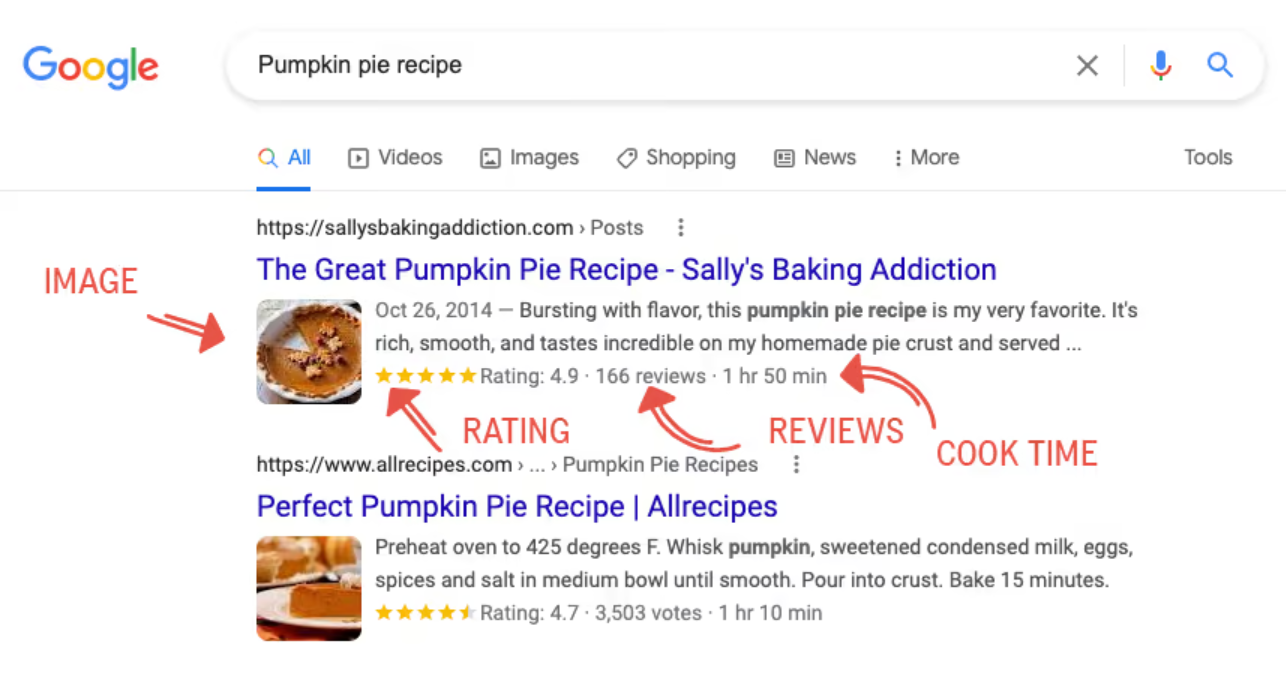Intro (short, human)
Okay, quick truth: getting a rich snippet feels like showing up to a party and getting the best canapé before anyone else even knows there’s food. It’s valuable, visible, and drives clicks. If your keyword is “rich snippet” (or any other target phrase), this post is the practical playbook – not theory, actual stuff you can do tonight.
What exactly is a rich snippet? (no fluff)
Rich snippets are those special search results that show extra info – star ratings, recipes with cook times, FAQ dropdowns, product price bullets, etc. Google uses structured data (schema.org markup) plus its own signals to decide when to display them. They make your result bigger, more clickable, and often steal traffic from plain blue links.
Types of rich snippets you can target
- Featured snippet (position zero) – short answer box at top (paragraph/list/table).
- FAQ rich results – expandable Q&A directly in SERP. Great for “how” questions.
- Recipe – cook time, calories, reviews (food sites love these).
- Product – price, availability, ratings (e-commerce gold).
- Review – star ratings and score.
- HowTo – step-by-step instructions with structured data.
- Video – video thumbnail + timestamp (useful for tutorials).
Pick the one that matches user intent for your keyword. If people searching your keyword want a quick definition, aim for a paragraph featured snippet. If they’re shopping, go product/schema.
Why you should care (brief)
Rich snippets increase click-through rate (CTR), improve perceived authority, and often drive more qualified traffic. They’re especially useful for long-tail and question-based keywords. Also, even if you don’t get the featured snippet, having schema can help Google better understand your page.
The signals Google looks at (in plain terms)
- Clear, direct answer to the query (for paragraph/list snippets).
- Well-structured content: headings, bullet lists, tables.
- Use of schema markup (but schema alone doesn’t guarantee a snippet).
- Page authority and relevance (links still matter).
- User behaviour: if people click and don’t bounce, Google notices.
Think of schema as a polite label on a box; Google still opens the box and checks what’s inside.
Step-by-step: How to create a rich-snippet-ready page for your keyword
1. Understand search intent for your keyword
Go to Google, type your keyword, and see what’s shown. If you see a how-to box, copy structure. If you see a product carousel, you need ecommerce signals. Don’t guess – observe.
2. Create a concise answer (for featured snippet)
If targeting a paragraph snippet: create a 40-60 word clear answer right after an H2 that contains your keyword. Example:
H2: What is a rich snippet?Short answer (40-60 words): A rich snippet is a search result enhanced with extra information (like ratings or a recipe card). Google shows them to give users quick answers – they’re created by combining page content with structured data (schema.org).
Google often pulls that exact first paragraph as the featured snippet.
3. Use the right HTML structure
- Use headings (H1, H2, H3) with your keyword in at least one H2/H3.
- Use bulleted or numbered lists for list snippets.
- Use tables for comparison or stat-rich content (featured table snippets love these).
- Keep the direct answer close to the top of the content – avoid hiding it under 1,500 words.
4. Add schema markup (structured data)
Implement JSON-LD schema for the relevant type:
- FAQPage for FAQ rich results.
- HowTo for step guides.
- Recipe for food.
- Product or Review for ecommerce.
Don’t overdo it: the schema should reflect visible content on the page. Below I’ll include a sample JSON-LD for an FAQ (drop it into the page).
5. Optimize the rest of the page
- Use semantically related terms (LSI keywords).
- Provide useful images with alt text and schema for ImageObject if relevant.
- If it’s product content, include price, availability, and review schema.
- Speed and mobile-friendly layout – Google won’t show fancy snippets on slow pages.
6. Build relevance & authority
Even the best structured data won’t help if your page is unknown. Get a few contextual backlinks, internal links from your high-traffic pages, and social mentions. Authority + a strong answer = high chance of snagging the snippet.
7. Track and iterate
Monitor performance in Google Search Console (GSC). Check impressions, clicks, and whether you’re appearing for the target keyword. If you see low CTR, tweak the meta description or answer wording. If traffic falls, maybe your answer isn’t as helpful as the competing snippet – rewrite it.
Quick examples – copy-paste templates you can use
Featured snippet (paragraph)
H2: How does a rich snippet work?
Answer paragraph (50 words): A rich snippet enhances a search result with extra data like ratings, images, or step-by-step instructions. Google chooses rich snippets by combining your on-page content with structured data (schema.org) and signals like relevance and page authority. Make your answer precise and place it immediately below a clear heading.
List snippet (for “best” or “top” queries)
H2: Top 5 tools to create rich snippetsUL:
- Tool 1 – quick note
- Tool 2 – quick note…
Google often pulls lists as featured snippets. Keep each bullet short (6-12 words).
HowTo snippet
Use a HowTo schema and break steps into numbered steps with short sentences and images where possible.
Mistakes people make (and how to avoid them)
- Stuffing schema for content that’s not actually on the page. (Google dislikes mismatch.)
- Hiding answers beneath long intros or ads. Put the quick answer near the top.
- Using auto-generated content that’s thin. Real, helpful content beats tiny AI-crafted snippets.
- Not matching intent. If SERP shows a list but you write a paragraph, you’re fighting a losing battle.
- Relying on schema only. Schema helps, but it’s not a magic ticket.
Measuring success (what to watch)
- Impressions and clicks in Google Search Console for the keyword.
- CTR increase after implementing schema and answer.
- Changes in rankings for related keywords (you might gain or lose positions).
- Traffic to the specific page from SERP features.
If your impressions jump but clicks remain low, tweak the on-page snippet (meta + H2 wording).
Advanced tips (for the impatient/ambitious)
- Use Q&A blocks within content to capture “People also ask” style snippets.
- Monitor competitor snippets and model structure (not content stealing).
- A/B test headings (slightly change wording and see which performs better).
- Use Schema validators: Rich Results Test and Schema.org docs to ensure correct syntax.
- Local snippets: If your keyword has local intent, add LocalBusiness schema and optimize Google Business Profile.
FAQs (useful for both users and as schema)
Q: Do I need schema to get a rich snippet?
A: No, but schema makes it easier for Google to understand your content. Many snippets still appear without schema, but using it improves your odds.
Q: How long before I see results?
A: Depends. Could be days, weeks, or months. If Google already crawls your site often, changes can appear fast. Use URL Inspection → Request Indexing in GSC to nudge Google.
Q: Can I get multiple rich snippets for one page?
A: Sometimes – a page can show as a featured snippet and include review stars or a video, depending on the SERP. But don’t force unrelated schemas.
Q: Will schema guarantee a rich snippet?
A: No guarantee. It’s one signal among many. Quality content and relevance still rule.
Sample FAQ JSON-LD Schema (drop into page)
<script type=”application/ld+json”>
{
“@context”: “https://schema.org”,
“@type”: “FAQPage”,
“mainEntity”: [
{
“@type”: “Question”,
“name”: “Do I need schema to get a rich snippet?”,
“acceptedAnswer”: {
“@type”: “Answer”,
“text”: “No, but schema makes it easier for Google to understand your content and can increase your chances of getting a rich snippet.”
}
},
{
“@type”: “Question”,
“name”: “How long does it take to see rich snippet results?”,
“acceptedAnswer”: {
“@type”: “Answer”,
“text”: “It varies. Changes can show up in days or take weeks, depending on crawl frequency and competition for the keyword.”
}
},
{
“@type”: “Question”,
“name”: “Can one page get multiple rich snippets?”,
“acceptedAnswer”: {
“@type”: “Answer”,
“text”: “Yes, sometimes. A single page may display as a featured snippet and include review stars or a video, but it’s not guaranteed.”
}
}
]
}
</script>
Final thoughts – be useful, be structured, be patient
If I had to give one blunt tip: write the best, clearest answer for the query and make it obvious to both humans and machines. Use schema to label it, structure it so Google can pull it easily, and keep working on authority so Google trusts you.
Rich snippets are partly technical and partly editorial. Do the basics – clean structure, correct schema, relevant backlinks – and your chance of winning that shiny SERP spot improves massively.
If you want, I can:
- Create the exact HTML + JSON-LD snippet for your specific keyword and page, or
- Audit one of your pages to suggest where the short answer should go and what schema to use.
Which would you prefer?


